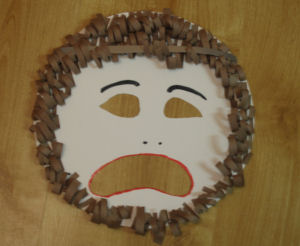“I was shocked when I saw what he had done in class. The psychologist said that’s the kind of thing he wouldn’t be able to do.”
“You’re going to try and teach your class to use sewing machines? Do you think they’ll even be able to?”
“You don’t really think beginner immersion students can memorize an entire play’s worth of lines, do you?”
At least once a year (and usually much more often than that), I have a conversation with someone – parent, colleague, administrator, student – who tells me that something I’m doing in class is “impossible” for one reason or another. Sometimes, like the first comment above, it’s an incredulous parent who is impressed (albeit confused) that their child was able to do something that shouldn’t have been possible. Other times, it’s well-meaning fellow educators who, I think, are trying to keep my lofty newbie expectations in check.
It’s okay, guys. I have this. My students can do it.
I’m not saying that I’ve never tried something that failed horribly (student-created team games in Grade 4 Phys Ed, I’m looking at you) but for the most part, my wackier ideas actually do pan out. Sometimes it takes some creative intervention from me, other times it takes a lot of patience and dedication, other times still I have to admit that we didn’t end up where I had planned but that the activity still taught what I was hoping it would – but we get there!
I credit my dedication to trying new, challenging, ambitious class projects to two people.
The first was my Grade 7 and 8 French Immersion teacher, Mme Crystle Mazurek. I have to admit that I don’t remember a lot about those two years except the really awesome art activities we did, but MAN, did we do some cool things! We made quilts, 3D art out of foam and cardboard, batik designs on fabric using melted wax, linoleum printing… I loved being in her art class (even if her dog literally ate my homework one time). It was in her class (though I can’t recall if it was while I was in Grade 7 or 8, or if it was when she was my teacher again later in high school) that we started a coin collection to help a village in India, where she had spent time in her childhood with her parents, to purchase a buffalo. From those humble origins began an ongoing collection to alleviate some of the effects of poverty in India by buying tools which can be used for trades (such as sewing machines) or by sponsoring students to attend school outside the village. I check in on the fund regularly and have a hard time believing it’s come as far as it has – from old soup cans in classrooms collecting a few coins here and there to a charity raising several thousand dollars a year.
Mme Mazurek, in hindsight, also dedicated a lot of time to helping her students succeed. Some of us were not particularly great students – I may or may not have had a few detentions in my time, despite being an active participant in class – and yet she still managed to get us excited about learning. I never did my homework, but I actually remember one of the novels we read as a class (it was about teenagers in Lebanon), details of Canadian history I know I learned in that class (the Rebellion of Upper Canada comes to mind), and how gracious and funny she was when we played an April Fool’s joke on her by switching her desk with our English teacher’s identical desk across the hall. I think a lot of my interest in becoming a teacher came from her. She probably doesn’t know that. Maybe one day she’ll google her name and find this. None of this paragraph has anything to do with challenging the impossible, she was just a really cool teacher with a bright red pixie cut, leather pants, an awesome attitude, and a wealth of personal anecdotes to keep us interested.
The second was my first Associate Teacher while I was in teacher’s college. I had the extreme privilege of working with a phenomenal teacher, Mr. Bill Morton, in an incredible Grade 3/4 Gifted class. My time in the class was too short, as all practicum placements are, but even in my five weeks there he bestowed upon me a lifetime’s worth of wisdom about education. I’m not sure the word “impossible” is in his vocabulary, unless we’re talking about retiring. His Grade 3/4 students were already engaged in learning and rehearsing A Midsummer Night’s Dream when I started in his class. As I took groups out to work through scenes and break them down, I was amazed by how well they understood the material with very little prompting from me. Nine and ten year olds! Reading Shakespeare! Not just reading it, but actually understanding it. Given what I could remember of reading Shakespeare in high school (and those were plays which I would argue were easier to follow than A Midsummer Night’s Dream, read by teenagers who were given very explicit instruction on what the words meant, who STILL didn’t seem to understand that “wherefore” doesn’t mean “where”), that shouldn’t have been possible.
The point of all of this is that you’re going to hear and read about a lot of things that your students “shouldn’t be able to do”. Students with NVLD “shouldn’t be able to” illustrate a graphic novel with consistency and detail from one page to the next. Second year French Immersion students “shouldn’t be able to” write short stories. Ten year olds “shouldn’t be able to” design and sew quilts. Students with a long history of behavioral problems “shouldn’t be able to” have a year where they fully engage in class and take responsibility for their actions.
You won’t always succeed with the wacky, outlandish ideas you have, and sometimes no matter how hard you and your students try, it won’t work. That’s part of life. But you will almost certainly have more successes than failures, and even the failures teach you something.
Be that teacher who does something “impossible”.
Fair warning, though: it gets pretty addicting to overhear your students bragging about the cool things they did in class as they walk to the bus.



 math around how many showings of the play we would need to do if we had room for 35 seats in the classroom. We talked about what it would be like if we charged money for the show, what would we use the money for, how much would we get if we charged $0.25 per seat, $1.50 per seat, etc. What if your ticket included popcorn, how much would it cost? We purchased popcorn, popped it and measured how many servings we could get out of it. Then we did the math on how many bags we would need and how much we would need to charge for it. They worked out the math on how long the show was, how much time would be required between showings to get organized again, and then looked at the school schedule to see how many showings they could fit in during the day. They wrote reviews of the play for the newspaper, they wrote ads to go on the announcements, they even filmed commercials! They made a program to hand out, worked out how many copies they would need, they did it all.
math around how many showings of the play we would need to do if we had room for 35 seats in the classroom. We talked about what it would be like if we charged money for the show, what would we use the money for, how much would we get if we charged $0.25 per seat, $1.50 per seat, etc. What if your ticket included popcorn, how much would it cost? We purchased popcorn, popped it and measured how many servings we could get out of it. Then we did the math on how many bags we would need and how much we would need to charge for it. They worked out the math on how long the show was, how much time would be required between showings to get organized again, and then looked at the school schedule to see how many showings they could fit in during the day. They wrote reviews of the play for the newspaper, they wrote ads to go on the announcements, they even filmed commercials! They made a program to hand out, worked out how many copies they would need, they did it all. that was very interested in restaurants. So we incorporated the social studies of food from around the world, and we turned out whole class into a restaurant that served dishes from different places around the world. Again, we did advertising, signage, lots of math around how much we would need of different supplies, etc.
that was very interested in restaurants. So we incorporated the social studies of food from around the world, and we turned out whole class into a restaurant that served dishes from different places around the world. Again, we did advertising, signage, lots of math around how much we would need of different supplies, etc.

 can be accessed to ensure no child is left out. You should not be taking trips that include required content for essential learning and exclude students if they cannot pay. This is a huge equity issue.
can be accessed to ensure no child is left out. You should not be taking trips that include required content for essential learning and exclude students if they cannot pay. This is a huge equity issue.
 Make sure you bring all epi-pens, medications, therapy devices, and a first aid kit. I always bring my cell phone as well to call for help should I need to. You will want emergency contact info for all students on the trip as well to ensure you can contact parents if there is an emergency.
Make sure you bring all epi-pens, medications, therapy devices, and a first aid kit. I always bring my cell phone as well to call for help should I need to. You will want emergency contact info for all students on the trip as well to ensure you can contact parents if there is an emergency.